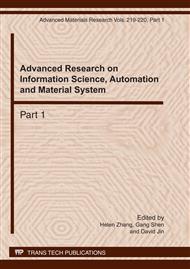[1]
Cozman, F.G: Credal networks, Artificial Intelligence Vol. 120, No. 2(2000), pp.199-233.
DOI: 10.1016/s0004-3702(00)00029-1
Google Scholar
[2]
Pearl, J: Probabilistic Reasoning with Intelligent Systems (Morgan & Kaufman, San Mateo, 1988).
Google Scholar
[3]
Cozman, F.G: Graphical models for imprecise probabilities, International Journal of Approximate Reasoning, No. 39(2005), pp.167-184.
DOI: 10.1016/j.ijar.2004.10.003
Google Scholar
[4]
Fagiuoli, E., Zaffalon, M.: 2U: An exact interval propagation algorithm for polytrees with binary variables, Artificial. Intelligence, Vol. 30, No. 1 (1998), pp.77-107.
DOI: 10.1016/s0004-3702(98)00089-7
Google Scholar
[5]
de Campos, C.P., Cozman, F.G: Inference in Credal networks using multilinear programming, Pro. .of the Second Starting AI Researcher Symp., Valencia (2004), pp.50-61.
Google Scholar
[6]
da Rocha, J.C.F., Cozman, F.G: Inference in Credal networks with branch-and-bound algorithms, Third International Symposium on Imprecise Probabilities and Their Applications, Carleton Scientific (2003), pp.482-495.
Google Scholar
[7]
Cano, A., Cano, J.E., Moral, S: Convex sets of probabilities propagation by simulated annealing, Proc. International Conference on Information Processing and Management of Uncertainty in Knowledge-Based Systems, Paris(1994), pp.4-8.
Google Scholar
[8]
Cano, A., Moral, S: A genetic algorithm to approximate convex sets of probabilities, Proc. International Conference on Information Processing and Management of Uncertainty in Knowledge-Based Systems, Granada, Spain, (1996), pp.859-864.
Google Scholar
[9]
Cano, A., Moral, S: A review of propagation algorithms for imprecise probabilities, First International Symposium on Imprecise Probabilities and Their Applications, Ghent, Universities Ghent (1999), pp.51-60.
Google Scholar
[10]
Cano, A., Cano, J.E., Moral, S: Simulation algorithms for convex sets of probabilities, Technical Report TR-93-2, DECSAI, Universidad de Granada (1993).
Google Scholar
[11]
Zheng, H: Credal Network and its Application on the Safety Assessment, PhD Thesis, Beijing Institute of Technology, Beijing (2007).
Google Scholar
[12]
Roth, D: On the hardness of approximate reasoning, Artificial Intelligence, Vol. 82, No. 1-2(1996), pp.273-302.
DOI: 10.1016/0004-3702(94)00092-1
Google Scholar
[13]
Duan, H.B: Ant Colony Algorithms: Theory and Applications, Science publishing company, Beijing (2005).
Google Scholar
[14]
Omkumar, M., Shahabudeen, P: Ant Colony Optimization for multi-level assembly job shop scheduling, Int. J. of Manufacturing Research, Vol. 4, No.4 (2009), pp.410-427.
DOI: 10.1504/ijmr.2009.028538
Google Scholar
[15]
Zhou, R., Lee, H. P., Nee, A.Y.C: Applying Ant Colony Optimisation (ACO) algorithm to dynamic job shop scheduling problems, International Journal of Manufacturing Research, Vol. 3, No.3 (2008), pp.301-320.
DOI: 10.1504/ijmr.2008.019212
Google Scholar
[16]
Li, Y.L: Study and Its Application of Several Questions on Credal Networks, PhD Thesis, Beijing Institute of Technology, Beijing (2008).
Google Scholar
[17]
Li, X.L., Shao Z.J., QIAN, J.X: An Optimizing Method Based on Autonomous Animals: Fish-swarm Algorithm, Systems Engineering-theory & Practice, Vol. 22, No. 11(2002), pp.77-107.
Google Scholar
[18]
Wang, Y., Xie, J.Y: An Adaptive Ant Colony Optimization Algorithm and Simulation, Journal of System Simulation, Vol. 14, No. 1(2002), pp.31-33.
Google Scholar


